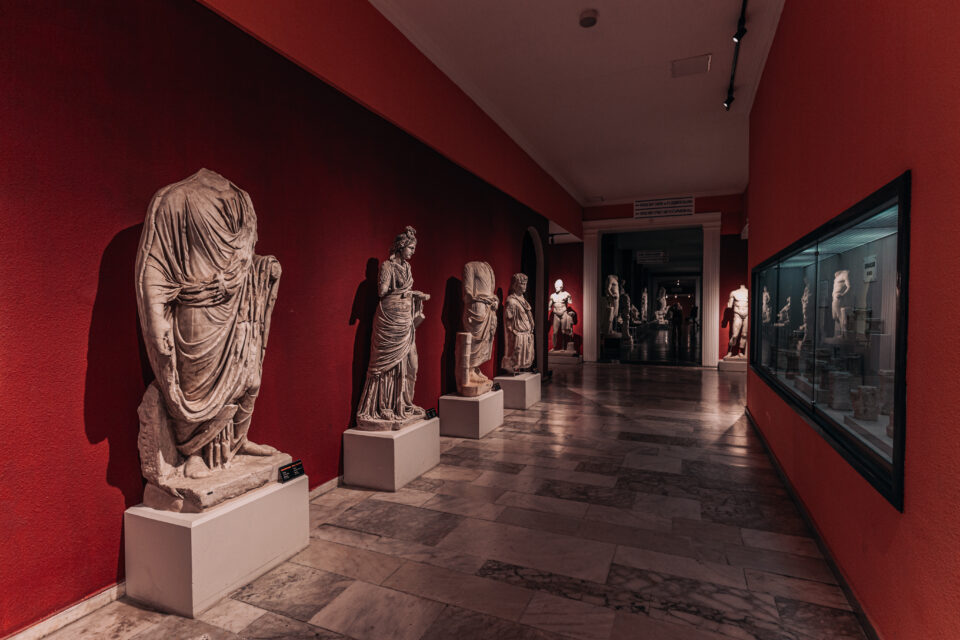A geography brimming with past treasures, Anatolia is home to the world’s oldest and most ancient civilisations and many firsts in history. Today, wherever you travel in Türkiye, these lands are captivated by their historical treasures and offer visitors a distinctive experience. Rich with a diversity ranging from UNESCO World Heritage sites to archaeological museums, Türkiye is an even timelier destination during Museum Week, celebrated annually between 18-24 May to protect cultural heritage and promote museology worldwide.
Türkiye’s Living Cultural Treasures
In terms of Türkiye’s numerous notable museums, İstanbul’s prominence is undeniable. As the cultural capital of a nation abounding in museums of different fields, in İstanbul, there is a museum for nearly every field of interest. However, if your time in the city is limited, the İstanbul Archaeological Museums is a worthwhile destination. This vast complex features a stunning collection of treasures, one of which is the building itself, housing many firsts — like the world’s earliest known love poem, the oldest known written peace treaty in history, and the oldest known law collection — as well as statues of Antiquity and the Sidon sarcophagi, unique works of art. For an art tour in İstanbul that incorporates museum explorations, you can visit the İstanbul Modern, the İstanbul Museum of Painting and Sculpture, the Pera Museum and the Sakıp Sabancı Museum, among others.
Within Anatolia are lesser-known but significant museums that illuminate the cultural evolution of the region and sometimes turn into social projects. Even some smaller villages contain museums recognised with the Council of Europe Museum Award. Türkiye’s larger cities host institutions holding the relics of the mighty kings of antiquity, the ancient civilisations and stories whose legends shape the narratives of today. In northwestern Türkiye, for example, the Museum of Troy in Çanakkale presents the narrative of the legendary Trojan War and a deep-rooted human heritage – a story that comes to us through Homer’s Iliad. Winner of the 2020 European Museum of the Year and the 2020/2021 European Museum Academy Special Award, this impressive museum depicts the life and archaeological history of Troy and the cultures that left their mark on the Troas region via artefacts recovered from excavations.
Türkiye: The World’s Largest Open-Air Museum
A journey through the Aegean Region of Türkiye, an area dotted with impressive ancient cities and museums, is a voyage through the history of civilisation. From the İzmir Archaeological Museum to the Bergama Museum and from the Aphrodisias Museum to the Bodrum Underwater Archaeology Museum in Bodrum Castle, these lands have a wealth of riches, traces of ancient civilisations at every turn. In Antalya, the heart of the Turkish Riviera, you will find a city similar to an expansive open-air museum and the Antalya Archaeological Museum, a temple of art dedicated to the three ancient cultural regions of Lycia, Pamphylia and Pisidia, which lay within the borders of the Antalya Region. Most of the artefacts in the collection of the Antalya Archaeological Museum were obtained from excavations in the region, and it is considered one of the most important museums in the world, especially with the sculptures of the Roman Period found in Perge and unique finds from the museum’s rescue excavations. The Antalya Archaeological Museum bears the title of 1988 Council of Europe Museum of the Year.
In Ankara, the Turkish capital and the heart of the country, you will find the Museum of Anatolian Civilisations, featuring an extraordinary collection and named Museum of the Year in Europe in 1997.
Among the world’s distinguished museums, it sheds light on the ancient Anatolian civilisations, with its sections covering the Palaeolithic Era, Chalcolithic Era, Early Bronze Age, Assyrian Trading Colonies Period, Early Hittite and Hittite Empire Period, Phrygian Kingdom, Late Hittite Kingdom, Urartian Kingdom, and Ages of Ankara and Classical Periods. In the Central Anatolia Region of Türkiye, where deep-rooted ancient civilisations from the Hittites to the Phrygians settled, dozens of museums have been established in cities such as Eskişehir, Konya, Cappadocia, Nevşehir and Çorum.
In the country’s southeast are the famed Zeugma Mosaic Museum in Gaziantep, one of the largest mosaic museums in the world, and the Archaeology Museum in Şanlıurfa, which houses the most extensive Neolithic collection in the world and the replica of Göbeklitepe.
The Golden Age of Turkish Archaeology
Anatolia is a treasure trove of museums and ancient cities, with 21 of the country’s cultural heritage sites inscribed on the UNESCO World Heritage List. Numerous heritage sites can be seen across the country, including Mount Nemrut in Adıyaman, the Ancient City of Gordion in Ankara, Göreme National Park in Cappadocia-Nevşehir, and Hattuşa in Çorum. From the Great Mosque and Hospital of Divriği in Siva to the Selimiye Complex in Edirne and the Diyarbakır Fortress and Hevsel Gardens Cultural Landscape, many structures and sites are meticulously protected, while artefacts preserved in the depths of Anatolian soil are being unearthed through intensive archaeological activities.
Drawing attention with its archaeological excavations and restoration projects in historical sites to ensure the sustainability of cultural heritage, Türkiye declared 2024 as the Golden Age of Archaeology. The number of archaeological excavations and studies in Türkiye is expected to reach 750 by the end of this year, and 800 by 2026. Moreover, as of this summer season, important ancient cities along the Aegean and Mediterranean coasts, including Troy, Ephesus, Olympos, Phaselis, Syedre, Perge and Aspendos, can be visited after sunset as part of the Night Museum Project initiative.

